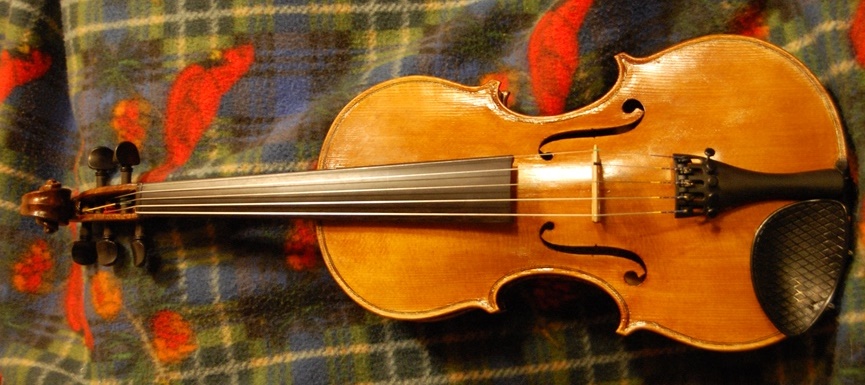Here (in reverse order, newest to oldest) are the handmade acoustic five-string fiddles I have made: (More on the way!)
~~~~~~~~~~~~~~~~~~~~~~~~~~~~~~~~~~~~~~~~~~~~~~~
NOTICE! Prices will increase, January 1st, 2026!
Sound files:
For some of these instruments, I had a young fiddler (Daniel Forster) play sample recordings, so you can hear them on “Vimeo”. He lives some distance away, so he is not always available. (Besides, some of these were sold before I could do more than snap a few photos, so that is all I have for them.)
More recently, Jenny Estrin, Concertmaster of the Eugene Symphony Orchestra recorded videos for some of the instruments, to show their capacity for both classical and fiddle applications.
~~~~~~~~~~~~~~~~~~~~~~~~~~~~~~~~~~~~~~~~~~~~~
Five-String Instrument #20: 15-3/4″ Oliver Five String Viola (SOLD)
(2025) A violist in Switzerland commissioned this five-string viola made of European Maple and Spruce. The client requested “Sonowood” for all the fittings. A Swiss company makes Sonowood wood by heating and compressing European Spruce (in this case) to produce a material rivalling the density and hardness of Ebony, but clearly not an endangered species. They also use other plentiful woods, producing a different look, but the client wanted this specific product.
I loosely modeled the instrument after the 1676 “Conte Vitale” Viola, by Andrea Guarneri. It has a powerful voice, well-balanced across all five strings.
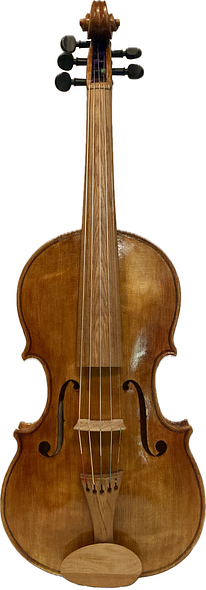

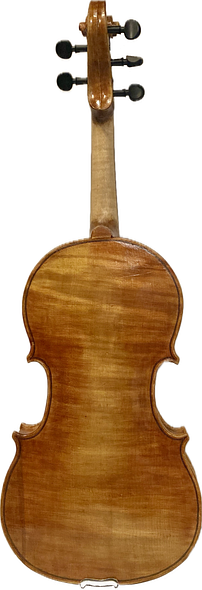
~~~~~~~~~~~~~~~~~~~~~~~~~~~~~~~~~~~~~~~~~~~~~
Five-String Instrument #19: Oliver Five String Fiddle
(Begun in 2024, but completed in 2025) I handcrafted this five-string fiddle of Eurpean Maple and European Spruce, both purchased from the International Violin Company in Baltimore, Maryland, at the same time as # 18, but the commissioned instrum,ent took precedence, and several medical events further exacerbated the wait. So it languished, nearly complet, until #20 was completed and gone. (No photos, just yet!)
~~~~~~~~~~~~~~~~~~~~~~~~~~~~~~~~~~~~~~~~~~~~~
Five-String Instrument #18: Oliver Five String Fiddle (SOLD)
(2024) I handcrafted this five-string fiddle of Eurpean Maple and European Spruce, both purchased from the International Violin Company in Baltimore, Maryland.
It had good sound from the beginning, and will only sound better as it continues to open up. It is a powerful instrument; very clear, and well-balanced across all five strings.
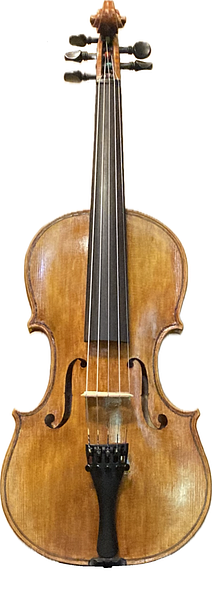

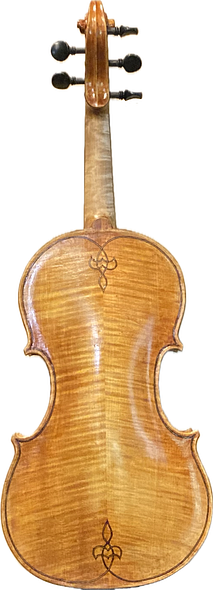
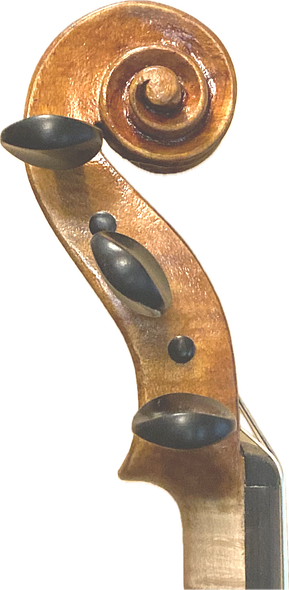
~~~~~~~~~~~~~~~~~~~~~~~~~~~~~~~~~~~~~~~~~~~~~
Five-String Instrument #17: Oliver Five String Fiddle
(2024) I handcrafted this five-string fiddle of “quilted” Big Leaf Maple and Englemann Spruce. Previously, both were part of a van-load of wood that I purchased from Bruce Harvie, of Orcas Island Tonewoods. (Geographically, in fact, Orcas Island is the largest of the San Juan Islands, in Washingto State.)
This instrument has good, clear, powerful tone, and also, it is well-balanced across all five strings.
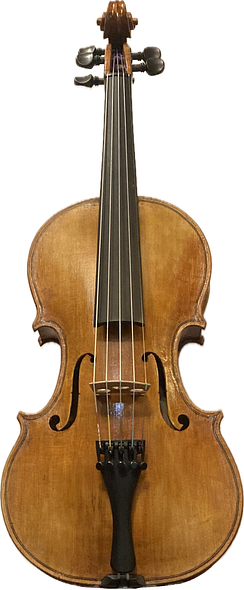

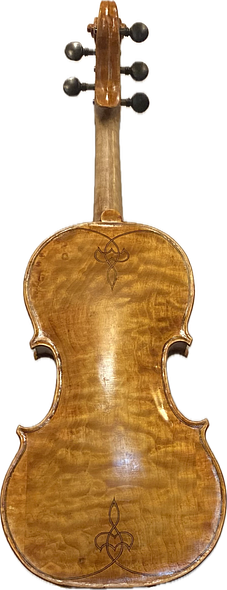
Five-String Instrument #16: Oliver Five String Fiddle (SOLD)
Most violin-family instruments have spruce top plates. In contrast, I used Douglas Fir for the top plate and bass bar on this instrument. Additionally, the back, sides and neck are Big Leaf Maple, salvaged from a tree on my wife’s parents’ property. (Furthermore, she and her siblings grew up climbing this tree and playing under it.) Therefore, together, those facts make this a special instrument. And, consequently, the customer loves it.
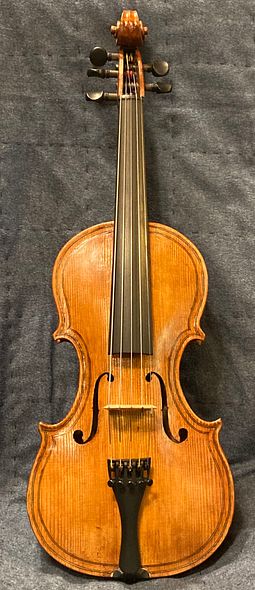

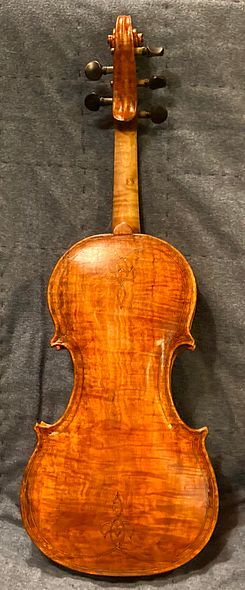
Five-String Instrument #15: Oliver Five String Fiddle
I got this wood from Bruce Harvie, of Orcas Island Tonewood, too. Accordingly, the back, sides and neck are Big Leaf Maple, and the front plate is Engelmann Spruce. I modeled this instrument after the 1735 “Plowden” by Guarneri del Gesu. It has a very strong voice, and it is very well balanced across all five strings, for both volume and tone quality.
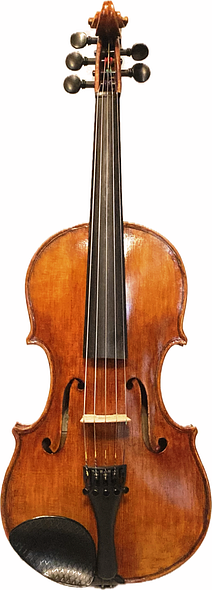

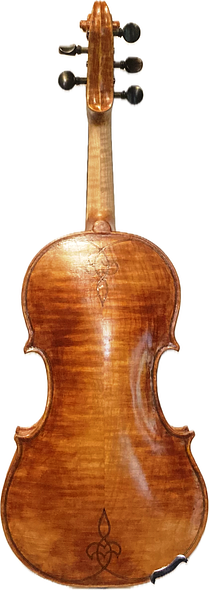
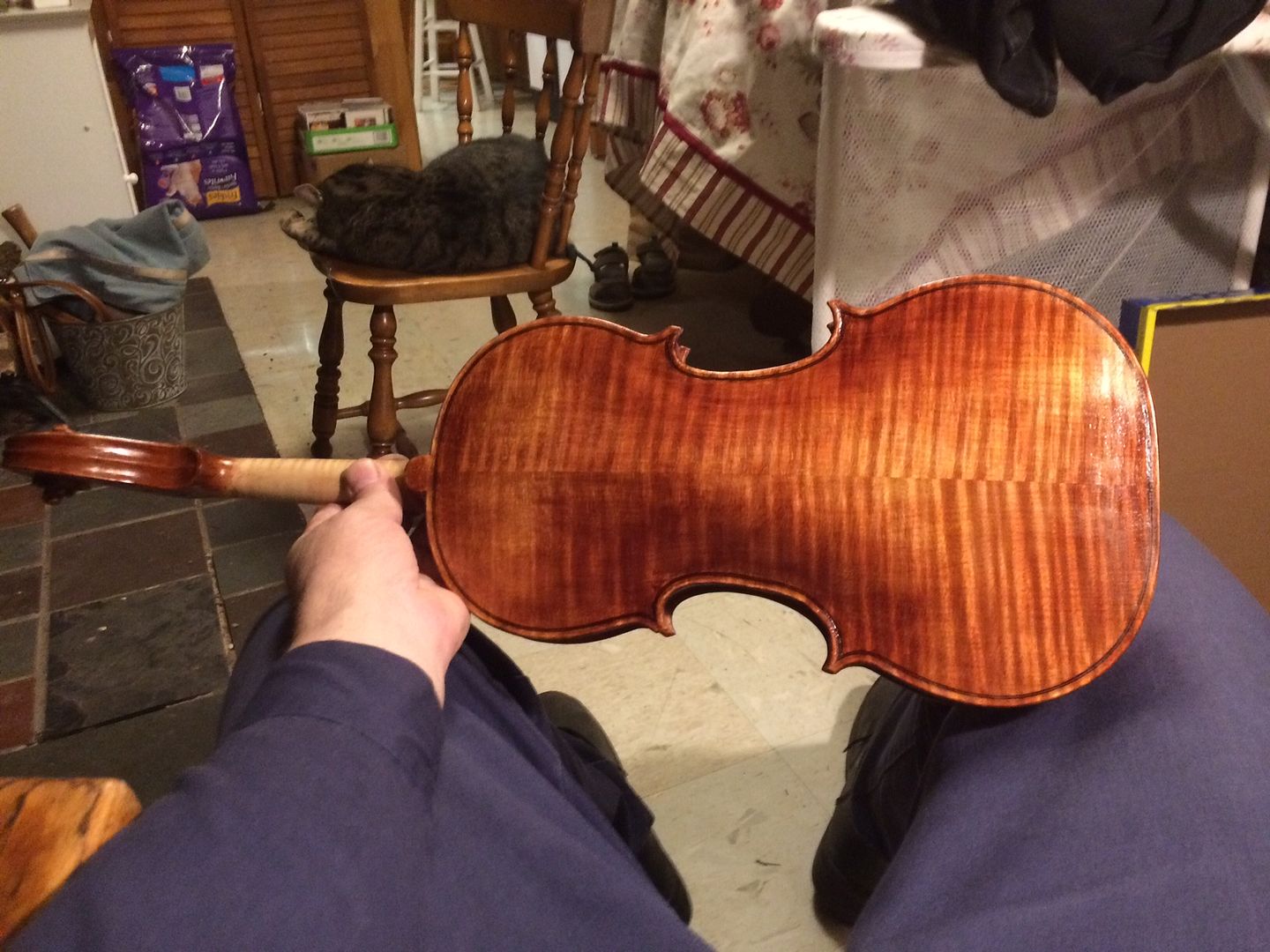
Five-String Instrument #14: Oliver Five String Fiddle (SOLD)
Bruce Harvie, the owner of the Orcas Island Tonewood company, sold me the Big Leaf Maple for the back, sides and neck of this instrument. In addition, another friend gave me some very straight-grained Douglas Fir. The instrument is loosely patterned after the 1728 “Milanollo by Antonio Stradivarius.
Douglas Fir is an unusual choice for a violin-family instrument, but not unheard of: It proved a good choice for the front plate. As a result, the instrument has a big deep voice, very strong and clear across all five strings.
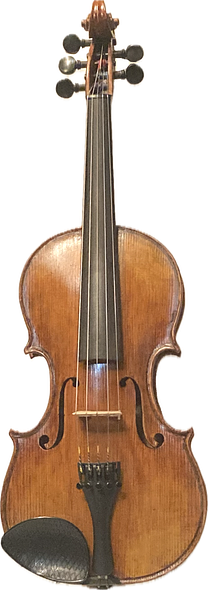

.png?width=590&height=590&fit=bounds)
Five-String Instrument #13: Oliver Five String Fiddle (SOLD)
I was pleased to offer this Five-String Fiddle from highly-figured and spalted Big Leaf Maple salvaged from a tree on my wife’s parents’ property. I refer to it as the “Vallery” tree, as it is from their propeerty, where Ann grew up. Now I wish I had a lot more of this wood, but, sadly, much of the tree was lost to rot. The front is made of Sitka Spruce. I made this instrument on a personal model, and, happily, the sound is very good, strong, and well balanced across all five strings.
.jpg)
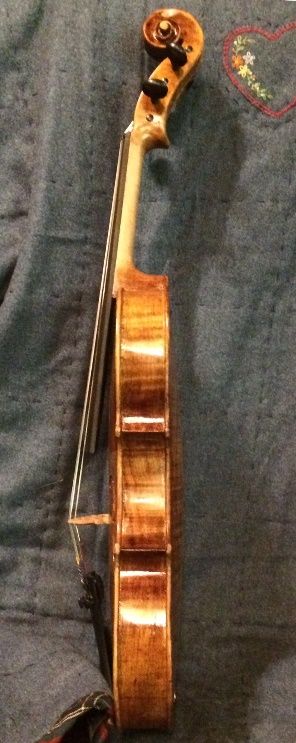
.jpg)
Here is a YouTube video of the above five-string fiddle (#13,) being played in a Canadian trio:
Five-String Instrument #12: Oliver Five String Fiddle (SOLD)
I made this instrument, also, from the scrap from the other side of the double bass, so it is the “sister instrument” of #11, below. In addition, it has a Douglas Fir top (which is unusual), a very powerful voice, very clear C-string, and perfect balance across all five strings.
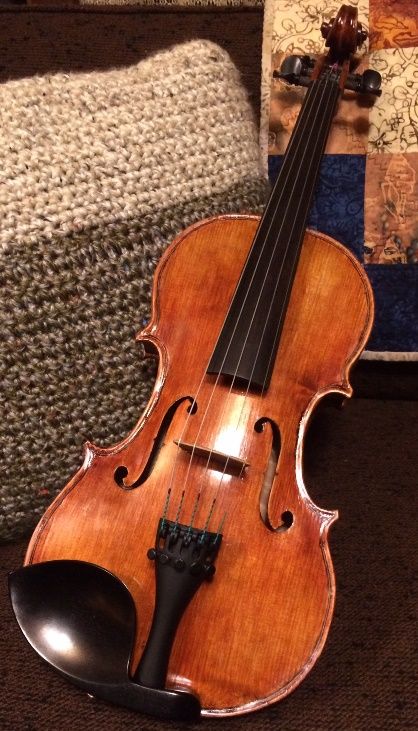
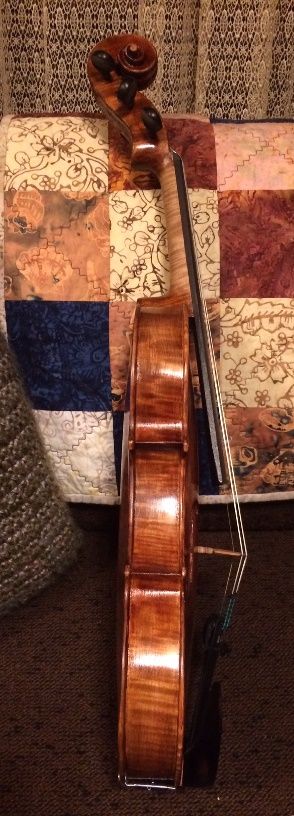
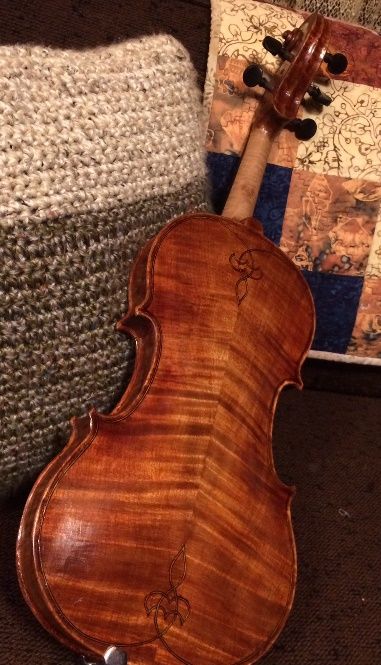
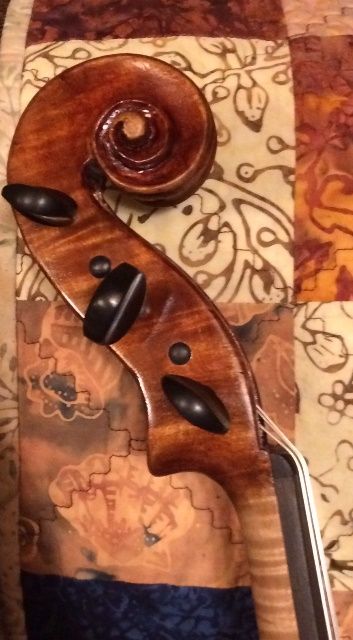
Five-String Instrument #11: Oliver Five String Fiddle (SOLD)
Originally, a customer called me and asked for a five string fiddle. He really wasn’t interested in the ones I had in stock, so, ultimately, I made this one for him from maple left over from the Five-String Double Bass built just before it.
I used Big Leaf Maple from just outside the Treble C-bout on the bass for the back and neck of this fiddle. With the Sitka Spruce front plate, the fiddle plays with a big voice: very clear and very well-balanced across all five strings. The customer is very pleased with his fiddle.
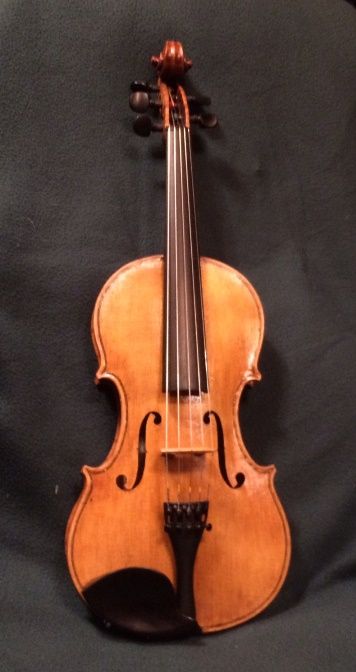
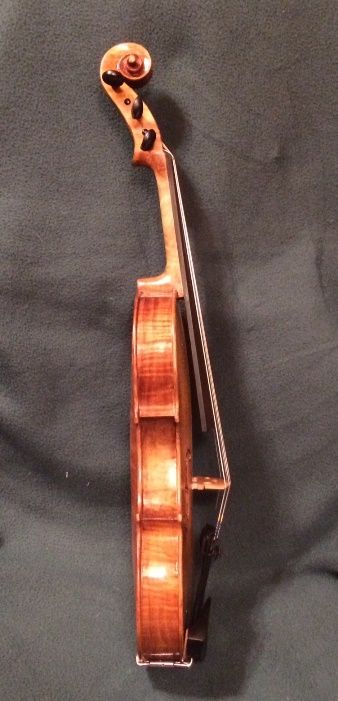
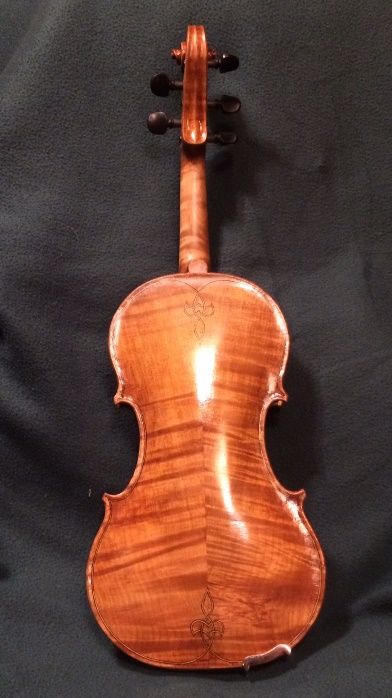
Five-String Bass #1: Oliver 5-string Double Bass with removable neck.
Just completed this bass in August of 2020: I am very satisfied with the new model. Originally, I had sketched the shape I wanted a bass to have, and later, I decided on the features I wanted in a bass. The result, years later, is my personal design.
I am especially pleased with this instrument, as it is my first five-string double bass as well as my first instrument with a removable neck. There are other choices possible, but eventually, I strung it “B-E-A-D-G,” which, of course, eliminates the need for an extension. Ultimately, it is what I would call a 5/8-size bass, with a D-neck and a 40″ scale. The bass produces good sound, well balanced across all five strings.
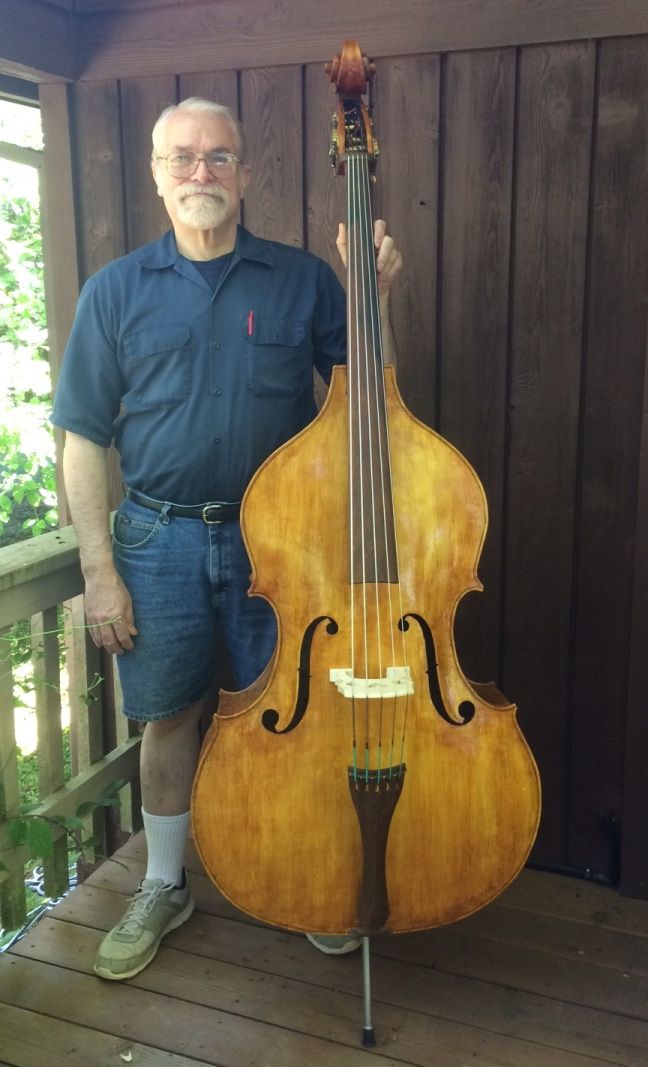
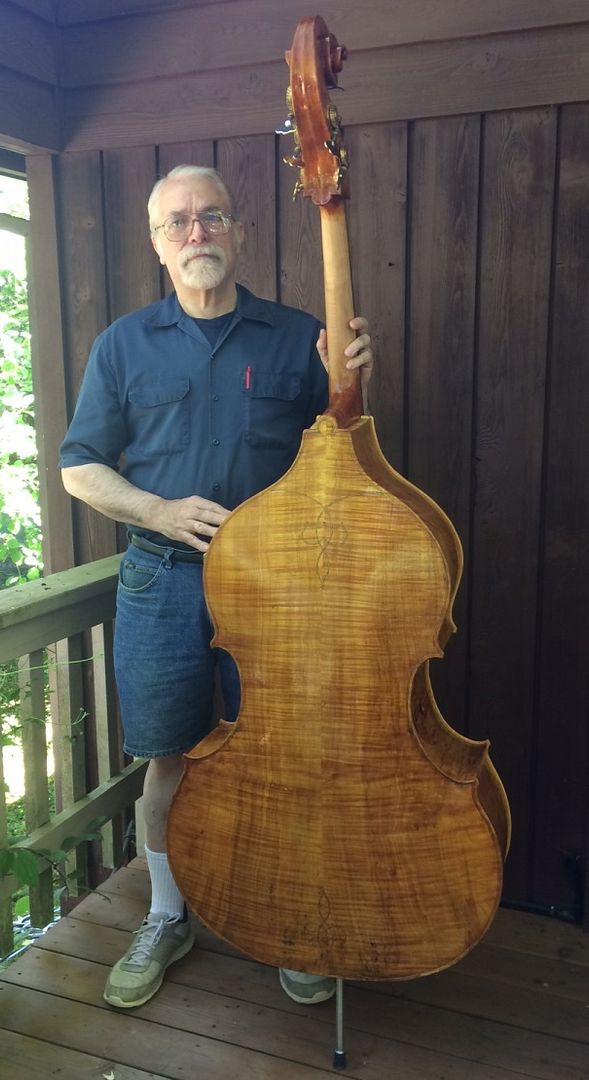
Five-String Instrument #10: Oliver 5-string 16-1/2″ Viola
A fellow at the Wintergrass 2020 festival had said he wanted a large five-string viola, so I made this one of European Maple and spruce. I haven’t any sound files for this instrument, yet, but I believe it is my best viola so far. It has an excellent, powerful voice, and well-balanced across all five strings.
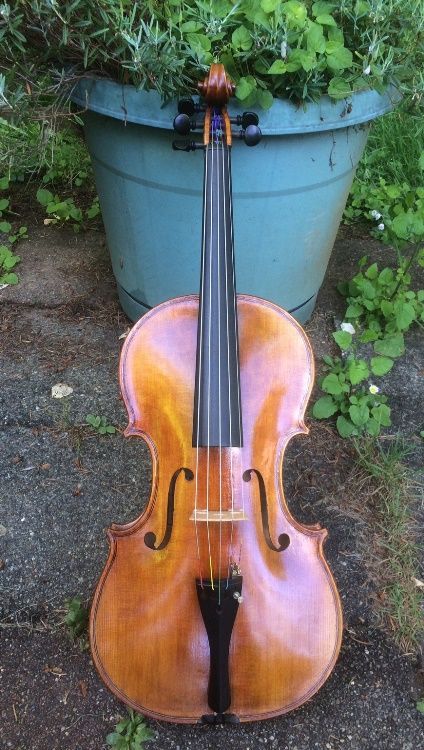
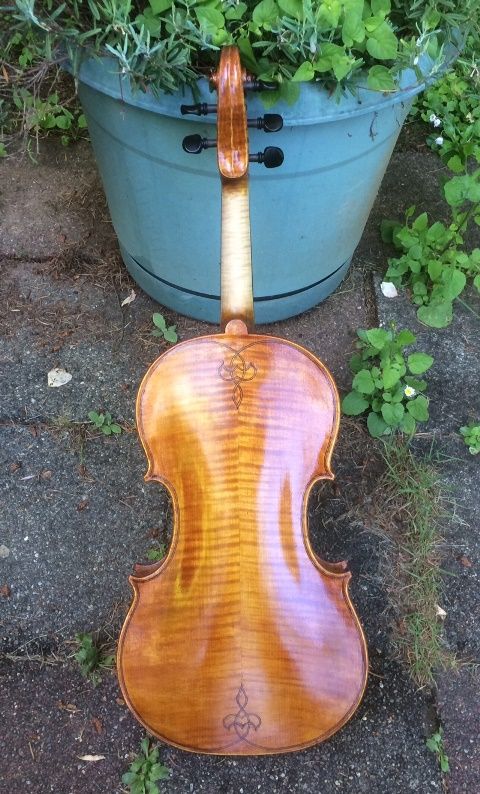
Five-String Instrument #9: Oliver 5-string 15″ Viola (SOLD)
Someone asked why I didn’t have more five-string violas, so, afterward, I made this one on the same mold from which I made my very first instrument. The viola I made, originally, was a four-string viola with abalone-shell inlay on the back, which I made for my youngest son. Since then, I have used the same mold at various times, but this is the first five-string viola from this mold.
For this viola, I chose the back, sides and scroll of Oregon Big Leaf Maple, heavily flamed, and spalted as well, as it was salvaged from a old tree in my wife’s parents’ yard. The belly is Sitka Spruce.
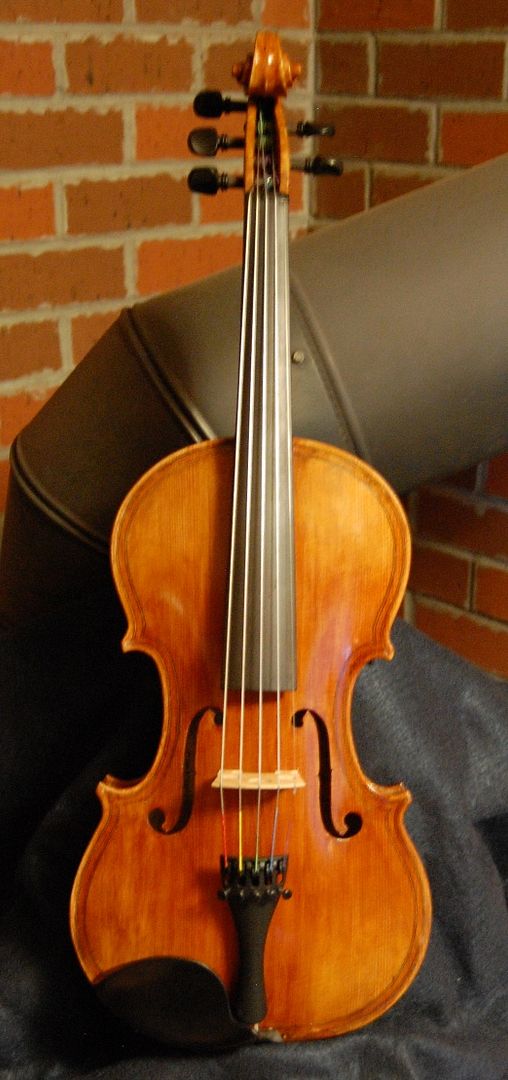
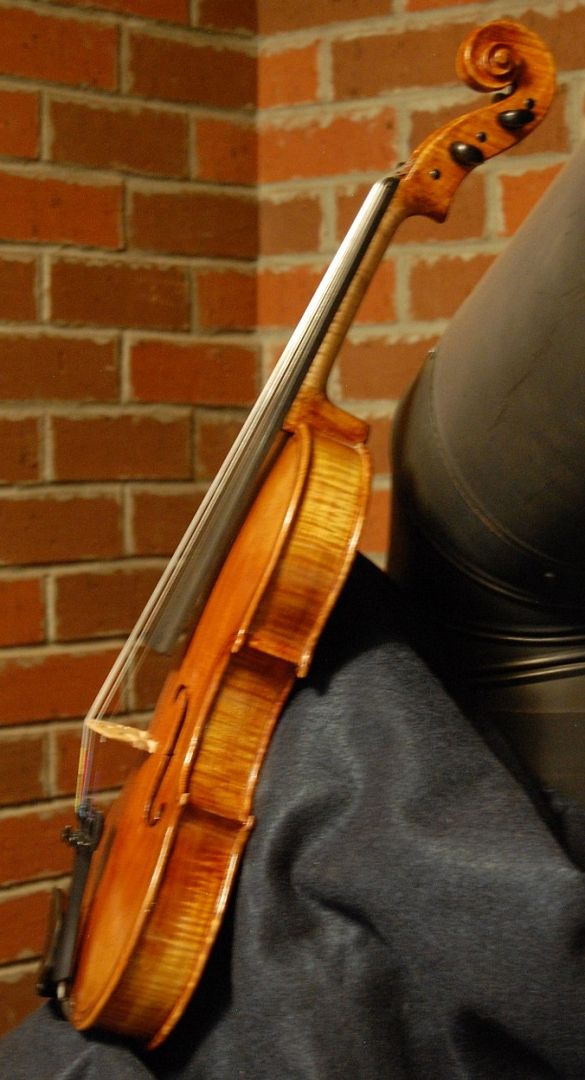
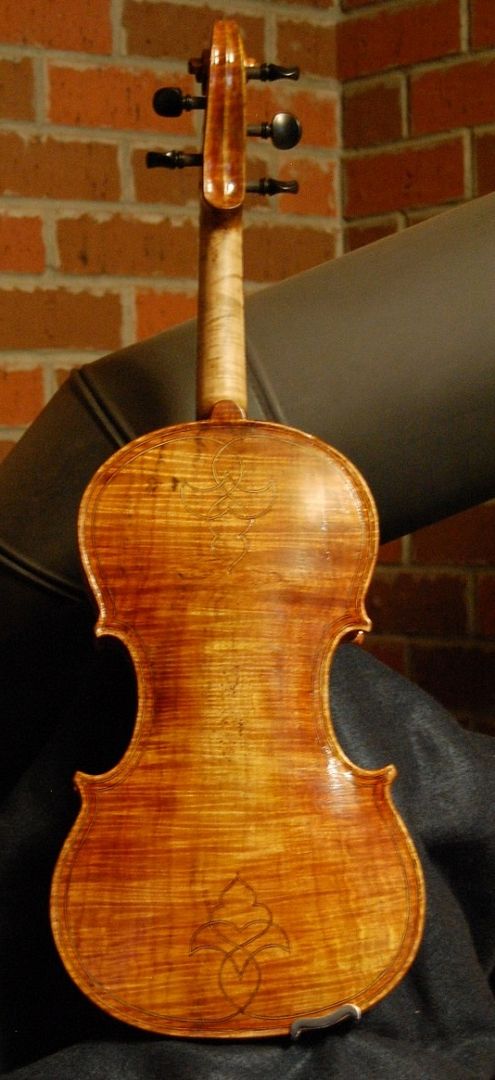
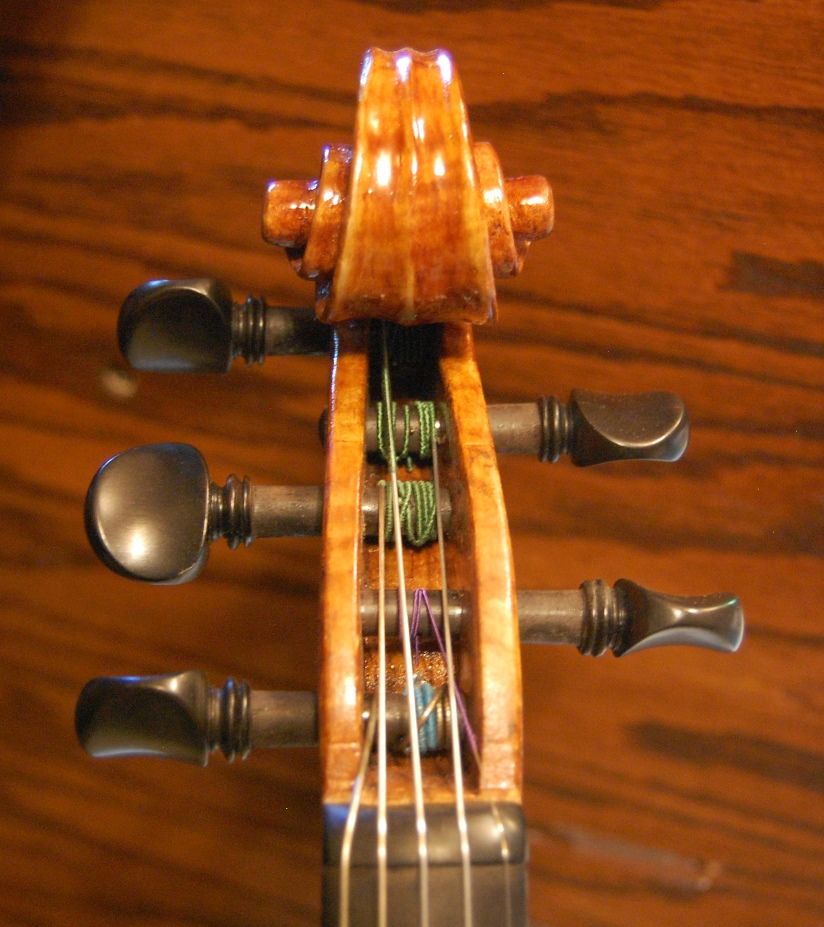
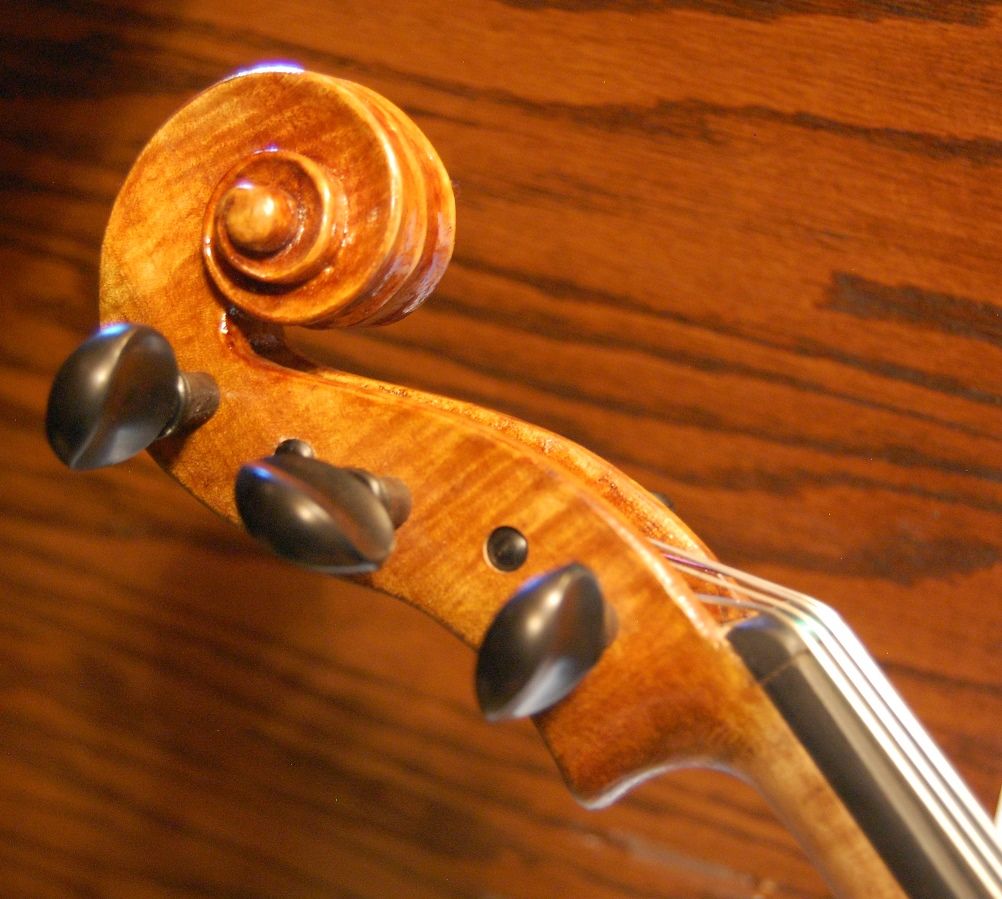
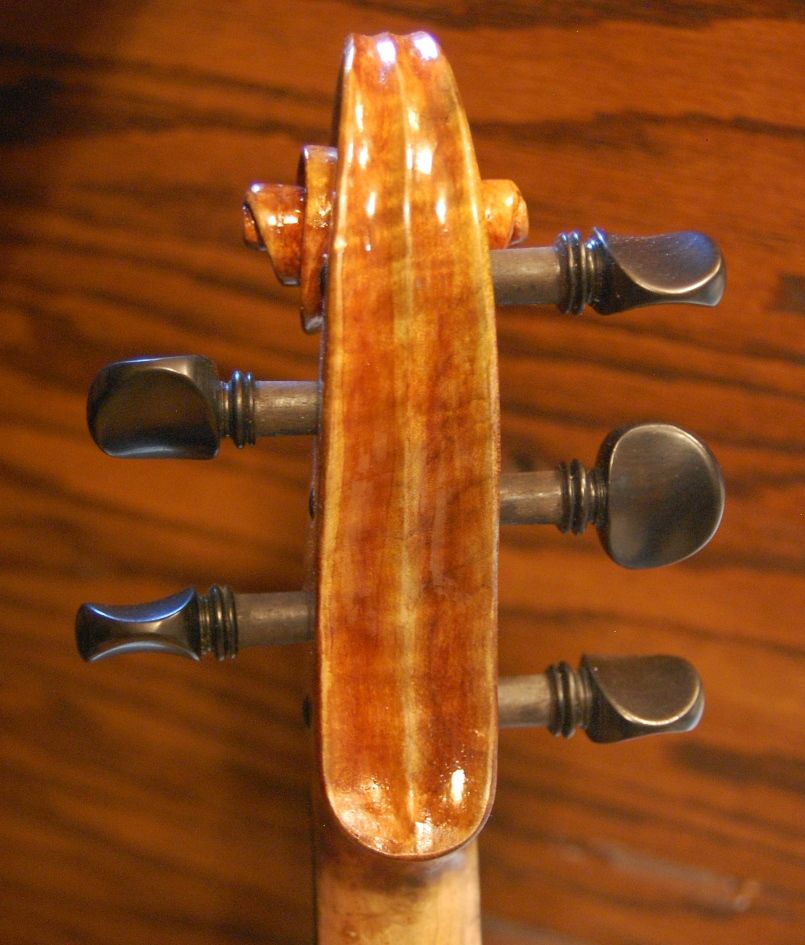
~~~~~~~~~~~~~~~~~~~~~~~~~~~~~~~~~~~~~~~~~~~~~~~~~~~~~~~~~~
Five String Instrument #8: Oliver Five String Fiddle (SOLD)
A customer emailed me, asking about a commissioned instrument: She wanted very specific things, such as Oregon tonewoods, Ipe wood for the fingerboard, nut and saddle, wide nut, high bridge, etc. She drove the 2-1/2 hours to get to my house, and then she spent several hours playing my available four- and five-string instruments.
After she had played all my instruments, then she could also say which particular model she liked, and what color and other specifics she liked. (She liked double purfling, with the fleur-de-lis purfling weave; and she liked heavily flamed maple, but very straight-grained spruce.) I began the commission on December 14th, 2019, and she eventually took possession of the instrument on February 29th, 2020. (She had very kindly allowed me to take the new instrument to the Wintergrass 2020 bluegrass festival, where it met with great reviews.)
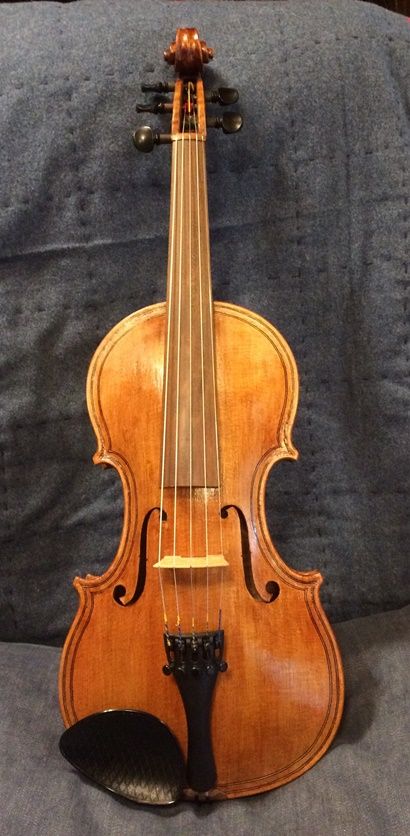
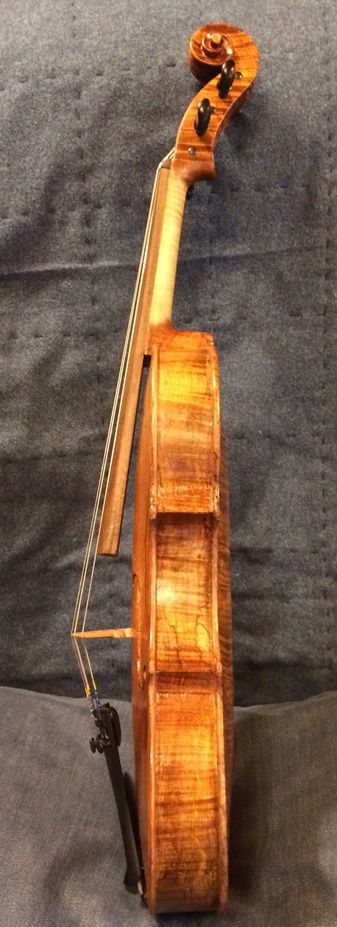
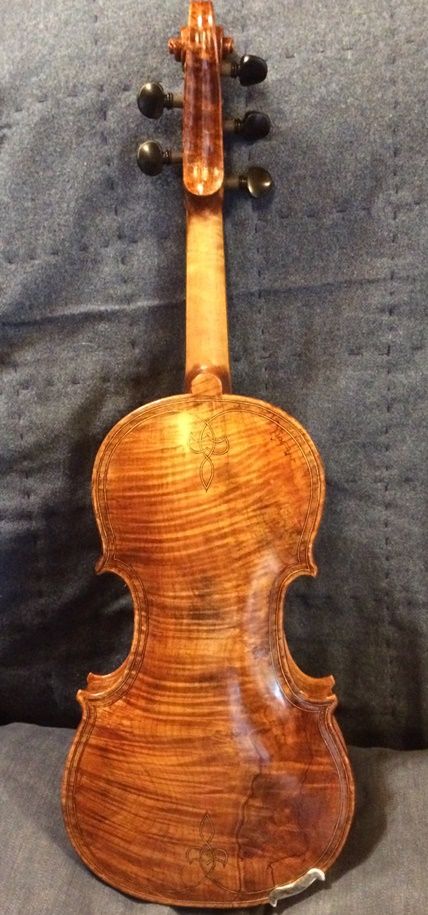
~~~~~~~~~~~~~~~~~~~~~~~~~~~~~~~~~~~~~~~~~~~~~
Five-String Instrument #7: Oliver 5-String 14″ ‘Tertis-style’ Viola .
Originally, I began this instrument as an experiment, not even being aware of what a “Tertis” viola looked like. (Of course, I had heard of Lionel Tertis, and his work, but I had never seen a “Tertis viola.”) Anyway, I was pleased that it turned out to be a pretty powerful little 5-string 14″ viola, and it sounds great. I am thrilled to hear it play, as it is well-balanced across all five strings.
After I had completed the instrument, a customer spotted the fact that it was similar to a Tertis. She said, “A 14″ Tertis! I’ll bet that would have made the old boy mad!” So, later, I looked for pictures of “real” Tertis violas on the internet, and it turned out she was right.
Terry Howell gave me the Big Leaf Maple for the one-piece back, the neck and the ribs (harvested near my home,) and the belly is Sitka Spruce.
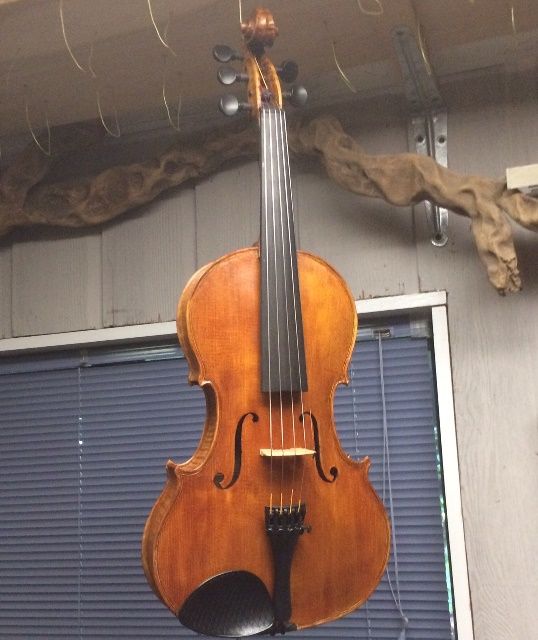
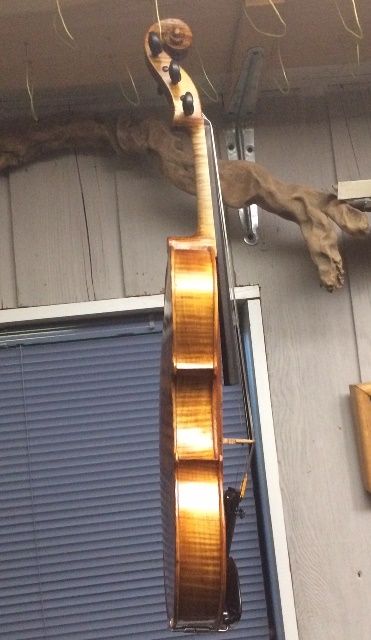
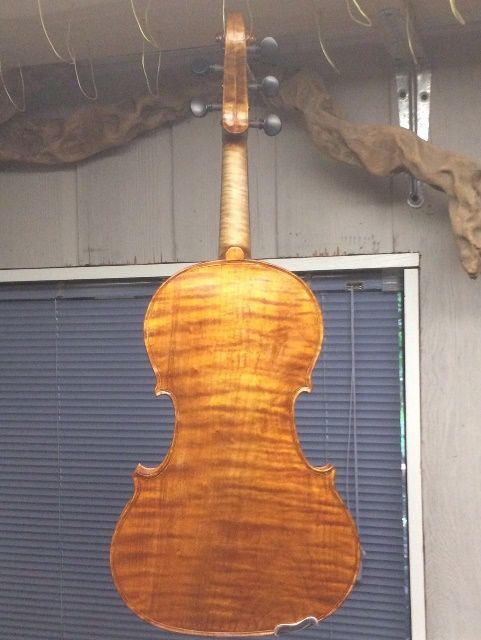
~~~~~~~~~~~~~~~~~~~~~~~~~~~~~~~~~~~~~~~~~~~~~
Five String Instrument (not numbered:) Oliver Violoncello Piccolo (SOLD)
Honestly, I only made parts of this one: That is why it is not numbered. A fellow had contacted me and expressed an interest in a handmade five-string cello. He eventually said he was leaning toward a violoncello piccolo, which was a relatively rare instrument from the early 1700’s, and which is credited to J. S. Bach.
When I researched the instrument, I found that the originals were about the size of a modern 1/2-size cello, but they had five strings. And… it is thought that the Bach Cello Suite #6 is written for just such an instrument.
I had an old, Romanian factory-made 1/2-size cello, which had been languishing in my shop. (Years earlier, I had made a new Englemann Spruce Top plate for it, because it had come to me missing that part.) But, no one had ever wanted it, so I simply knocked the original neck out of it, and carved a new neck and scroll, in a five-string configuration of my own design, and produced a “sample.”
The customer eventually flew in, and spent a couple of hours playing it and my other cellos. Ultimately, he left without placing an order, but the project was interesting, at least, and now I have built a small 5-string cello! 🙂 So, I can build more from scratch, if there is ever a resurgence in demand.
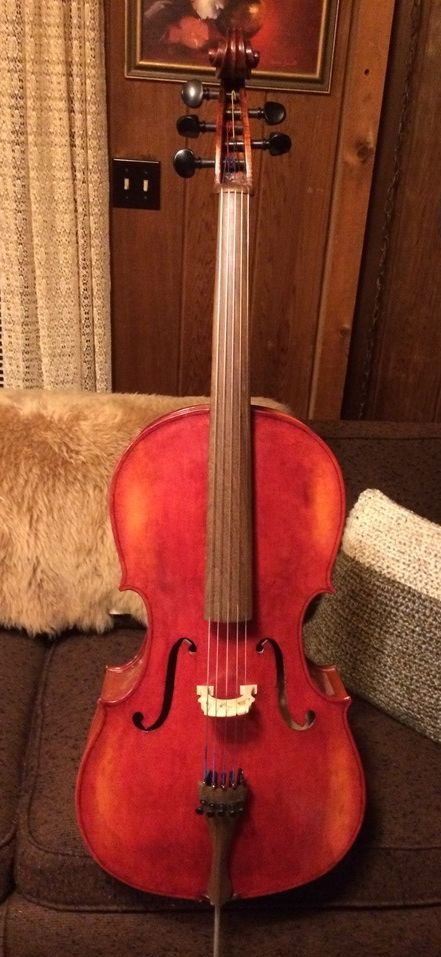

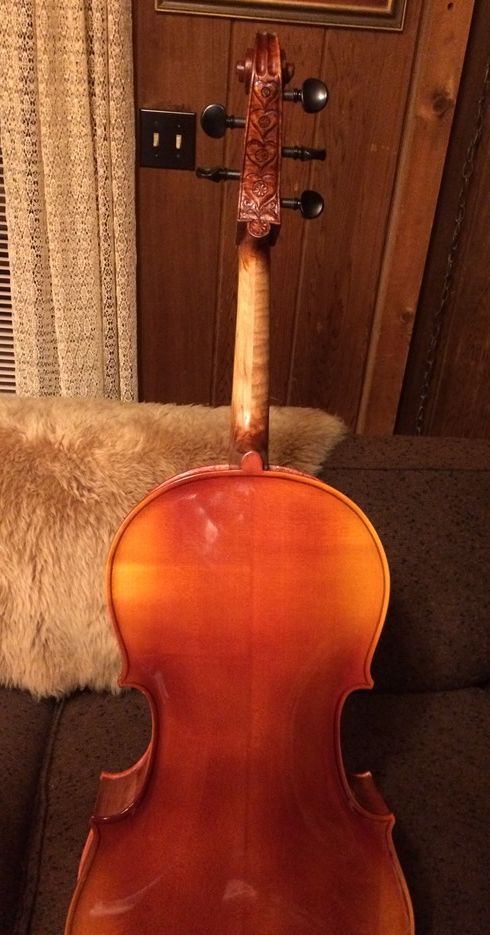
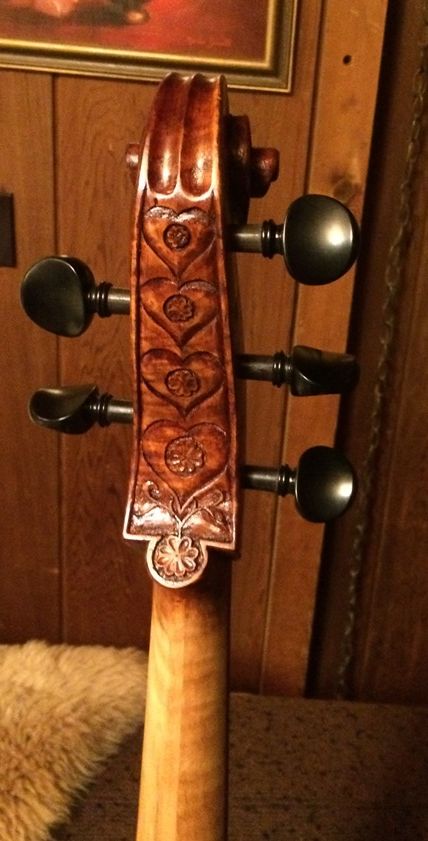
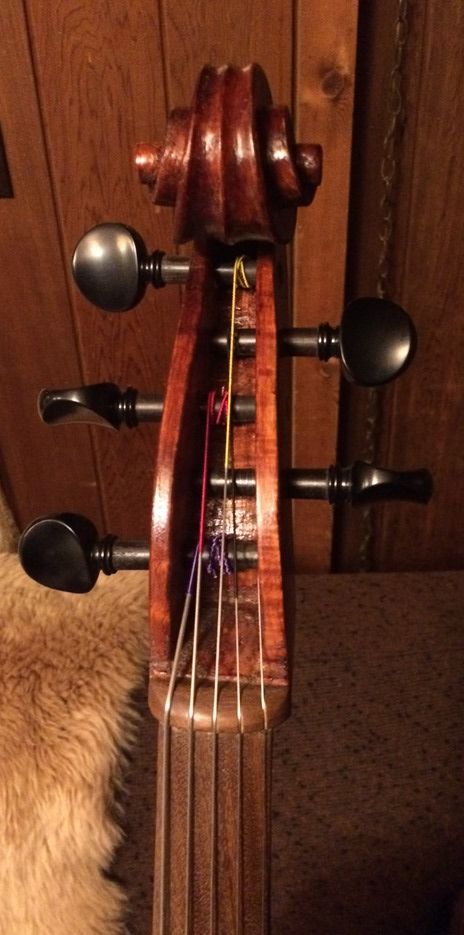
~~~~~~~~~~~~~~~~~~~~~~~~~~~~~~~~~~~~~~~~~~~~~~~
Five String Instrument #6: Oliver five-string fiddle (Sold)
Originally, I made this instrument “by request,” but not exactly as a commissioned instrument: more like an “experiment.”
To begin with, Cliff Stansell asked me to try making a fiddle of Oregon Myrtle and Port Orford Cedar. Besides, his brother, Les Stansell, makes guitars, and sells wood, and he kindly donated the wood for the experiment. (Thanks, Les!) And, of course, after they had gone to the trouble to get me the wood, I went ahead with the build. I’m glad I did!
Ultimately, I found that the fiddle played quite well, and it continued to improve as it opened up. Eventually, I sold it to a fiddler in Southern Oregon, who continues to be thrilled with the sound and playability.
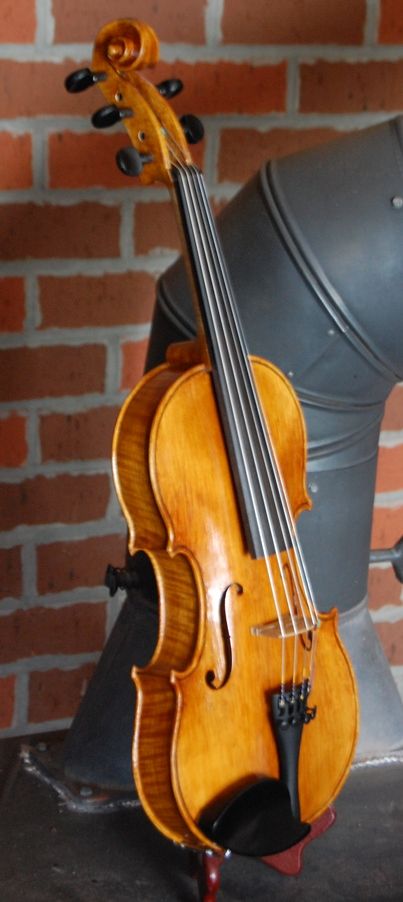

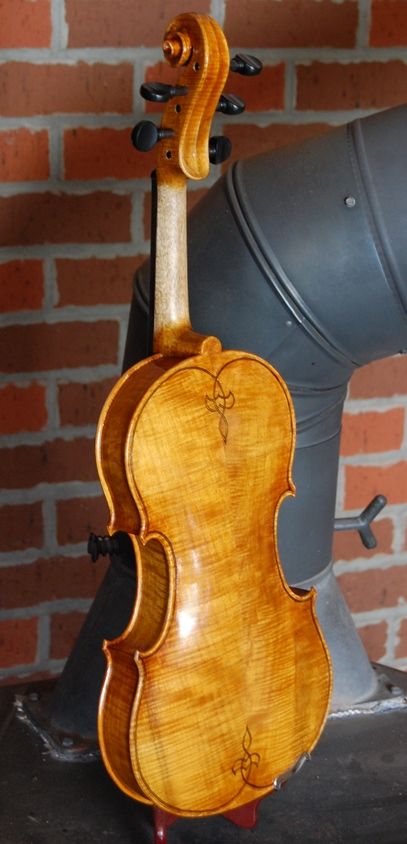
Fiddle #28 from Chester O. Bishop on Vimeo.
~~~~~~~~~~~~~~~~~~~~~~~~~~~~~~~~~~~~~~~~~~~~~~~~~~~~
Five String Instrument #5: Commissioned Oliver 5-string fiddle (SOLD) Read the Book, here.
From the beginning, I treated this instrument as a “special project.” To begin with, the customer came to me at a show, with the wood for the back, neck and ribs. Furthermore, he had asked whether I could build a five-string fiddle out of this wood he had bought in Hawaii; it turned out to be curly Koa, harvested in 1982 or before, as that is when he bought the wood, and he had been carting it around with him for over 30 years.
But, after accepting the commission, I discovered that Curly Koa was extremely difficult wood to work– very demanding of skill and patience. Ultimately, however, the instrument worked out well: It plays superbly. Finally, we chose Sitka spruce for the belly (front plate.)
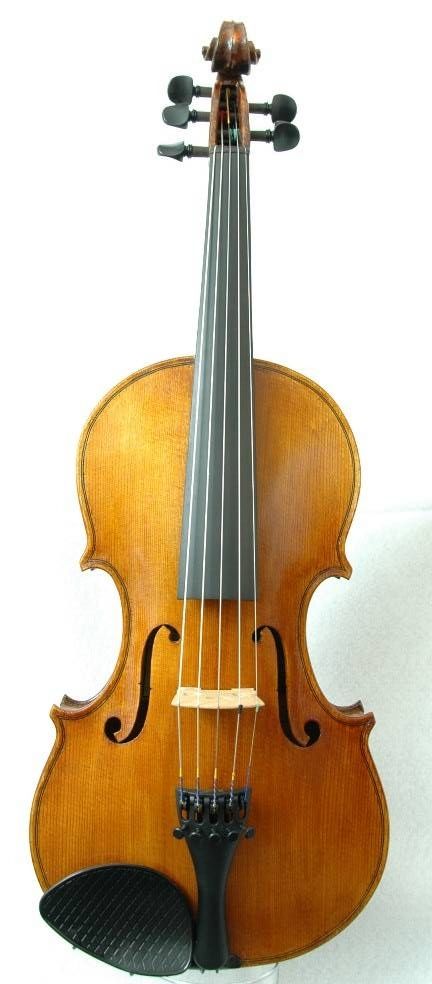

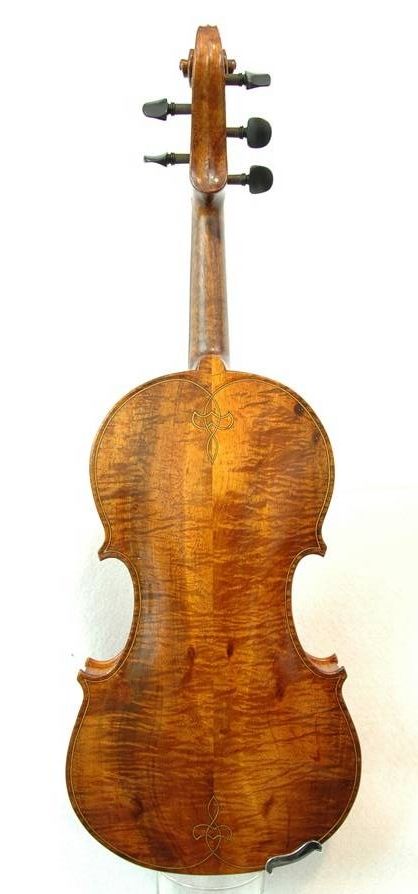
~~~~~~~~~~~~~~~~~~~~~~~~~~~~~~~~~~~~~~~~~~~~~~~~~
Five String Instrument #4: Oliver 5-String fiddle
I can’t say for sure what kind of maple this is. A friend, who has no idea what it was, gave me the maple: but the spruce is Sitka. He gave me a whole pile of things related to lutherie, including the wood, and later, I decided to make a five-string fiddle of the wood.
However, the fiddle plays well, sounds great and looks very pretty. I made it to the same mold as my other five-string fiddles. The wood will have to remain a mystery, but it has played well from the beginning, and, it has improved with time.
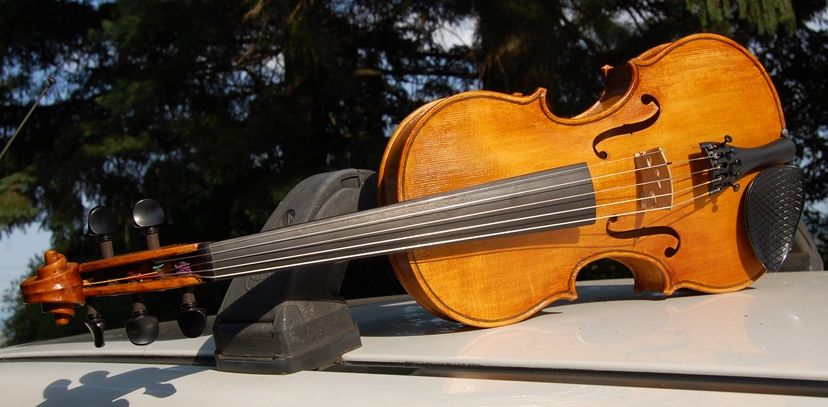

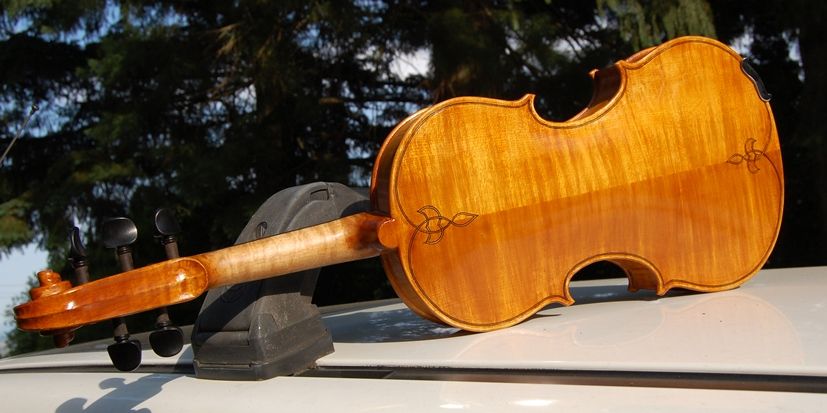
Daniel Forster on Instrument #26 (5-string #4) , a 5-string fiddle by Chet Bishop from Chester O. Bishop on Vimeo.
~~~~~~~~~~~~~~~~~~~~~~~~~~~~~~~~~~~~~~~~~~~~~~~~~~~~
Five-String Instrument #3: Oliver 5 string fiddle (SOLD)
Originally, I made this fiddle from Oregon Big Leaf Maple and Sitka Spruce on a personal model. It is only unusual in that it has both a one-piece back and a one-piece front. Additionally, we harvested the maple from the same tree as five-string instrument #2. (Since then, I have also made one cello, a bass and a viola from that log, and I have a lot more of that wood, so there will be more to come.) The customer is very pleased with this instrument, because it plays easily and has a powerful, big voice, a deep clear C-string, and good balance across all strings.
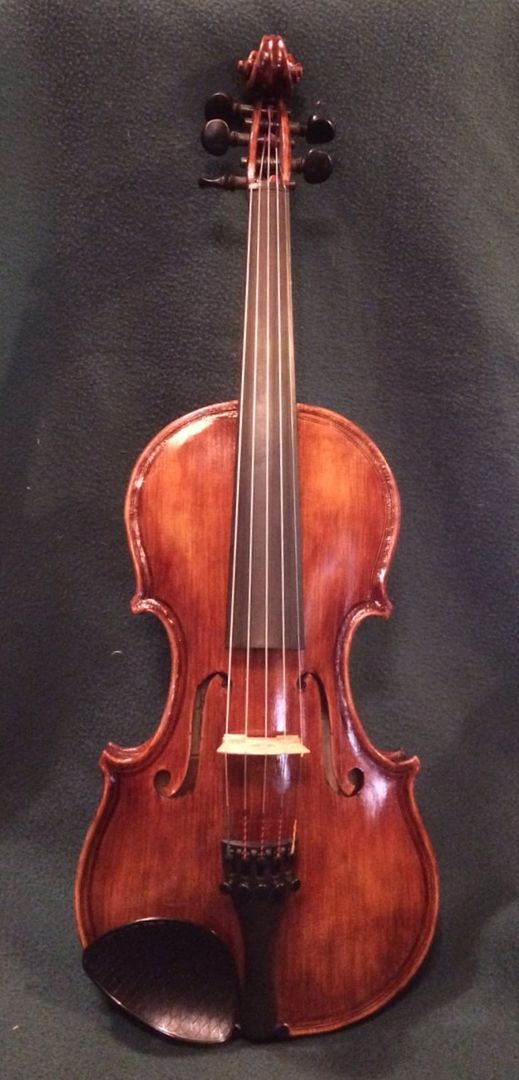

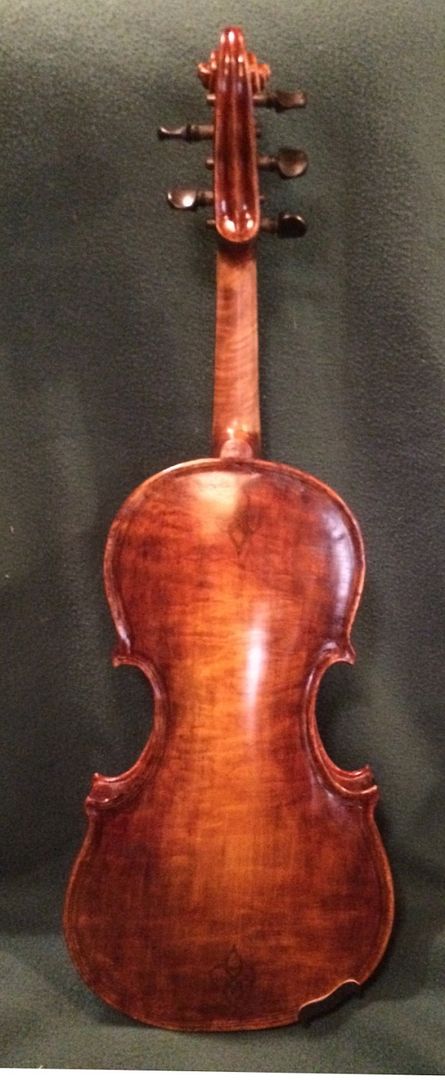
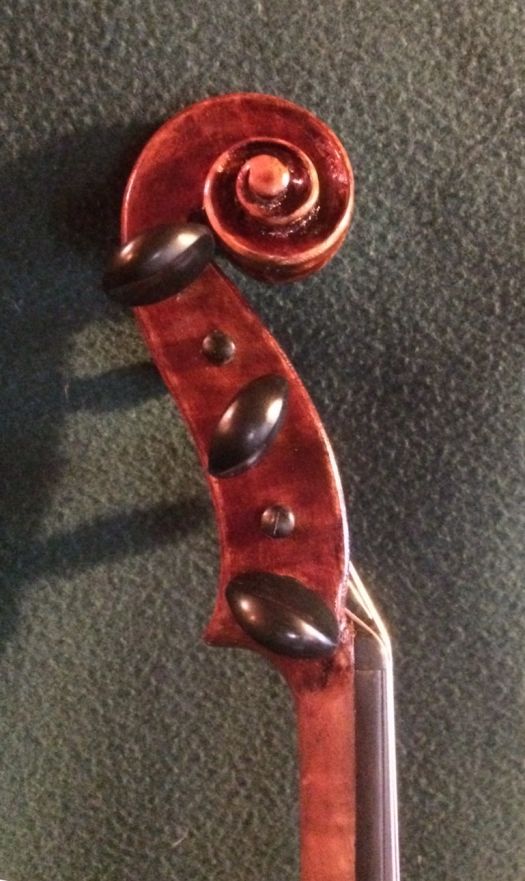
Daniel Forster playing Instrument #24 by Chet Bishop, Luthier from Chester O. Bishop on Vimeo.
~~~~~~~~~~~~~~~~~~~~~~~~~~~~~~~~~~~~~~~~~~~~~~~~~~~~~~~~~
Five String Instrument #2: an Oliver 5-string fiddle. (SOLD)
Soon after receiving the (well-seasoned) log, I made this instrument of Big Leaf Maple, from the log pictured in the “wood choices” blog post. After Terry Howell gave me that log, I was anxious to use some of it, so this is the first of many from that log.
Ultimately, the fiddle played very easily, and it looks and sounds wonderful. It sold immediately, and, sadly, I never saw it again, as the customer bought it and then moved out of the state.
Fortunately, five-string fiddles are rapidly gaining in popularity and demand, especially for musicians in bands. Therefore, I plan to build many more 5 string bluegrass fiddles in the years to come.

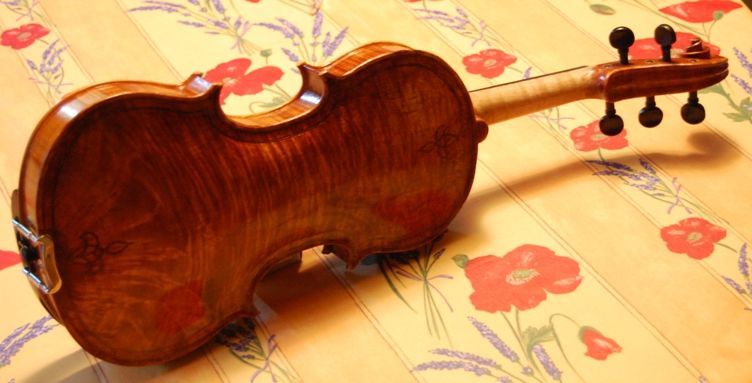
~~~~~~~~~~~~~~~~~~~~~~~~~~~~~~~~~~~~~~~~~~~~~~~~~~~
Five String Instrument # 1: An Oliver Five-String Fiddle (or five-string violin) SOLD
Previously, I had never built a 5-string fiddle: this was my first attempt. But, an experienced and popular professional fiddler (Cliff Stansell) from a Southern Oregon band (the Pistol River Trio) approached me at a show. After some conversation, he asked about them. In addition, he asked very detailed questions. Eventually, I decided I had better build one.
Initially, I used a back made of maple of uncertain origin (salvaged from a broken student instrument,) but the sides and neck are Red Maple from Elon Howe, in Newaygo, Michigan. And, I’m not sure where the Sitka spruce was harvested, but it is quite dense. Ordinarily, I do not use such dense wood for the belly. It turned out very well, though.
Of course, I had planned the instrument as a five-string from the start:
First, I made the ribs deeper, so that they are 34mm at the end block, tapering to 32mm at the neck block. Second, I also made the pegbox longer to accommodate the extra peg, and, Finally, I deepened the bass-bar to about 17mm, for more support on the lower strings. The archings are just a little higher than my usual, as well, but not out of the ordinary.
It plays remarkably well. It is well-balanced, and all, but I am not used to the flatter bridge shape that fiddlers like, so it was difficult for me to get used to it. Other than that, I’m very happy with it. Eventually, I took it to the same show the next year, and everyone who played it, loved it. And finally, Cliff bought it, himself. Now we are both happy. 🙂
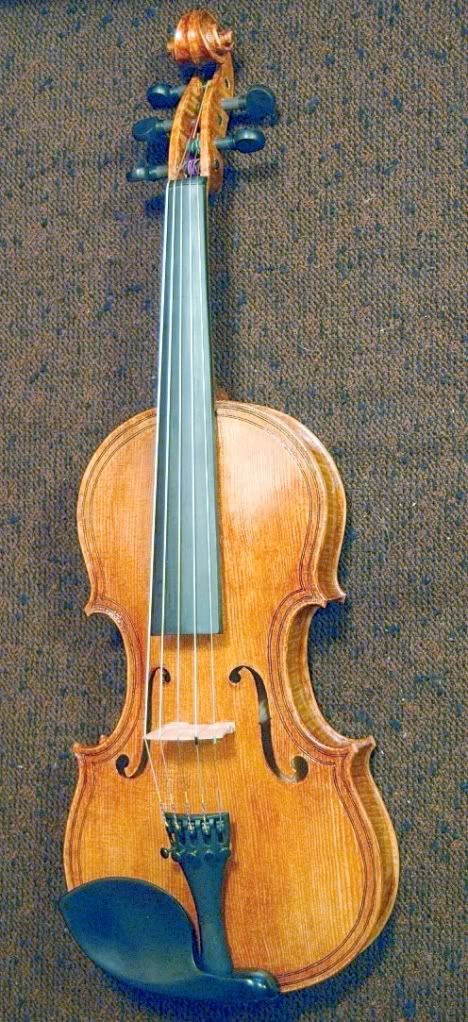
Front view of an Oliver Five-string Fiddle
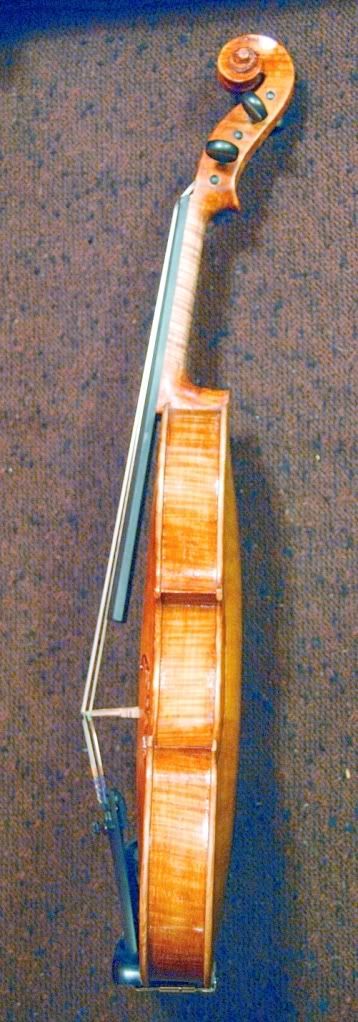
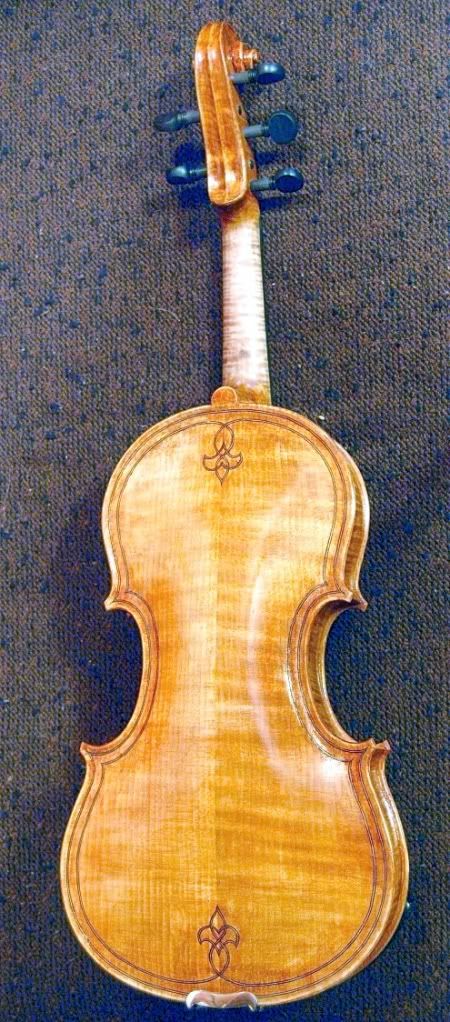
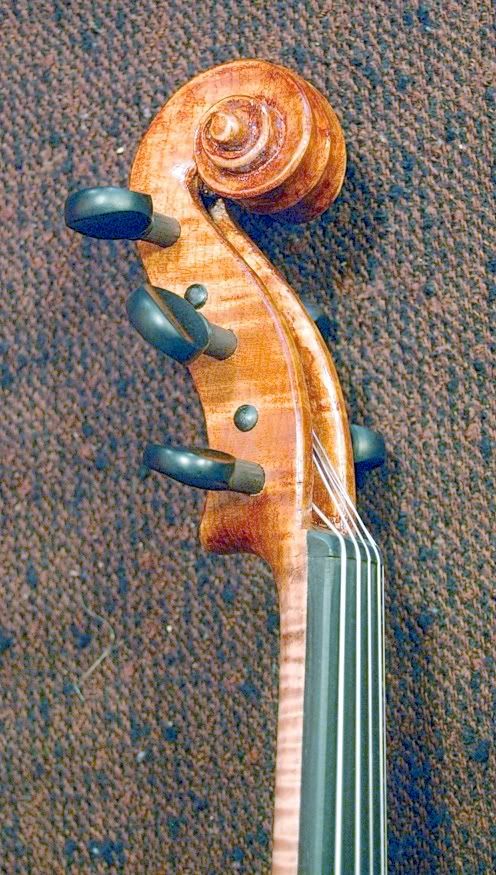
~~~~~~~~~~~~~~~~~~~~~~~~~~~~~~~~~~~~~~~~~~~~~~
